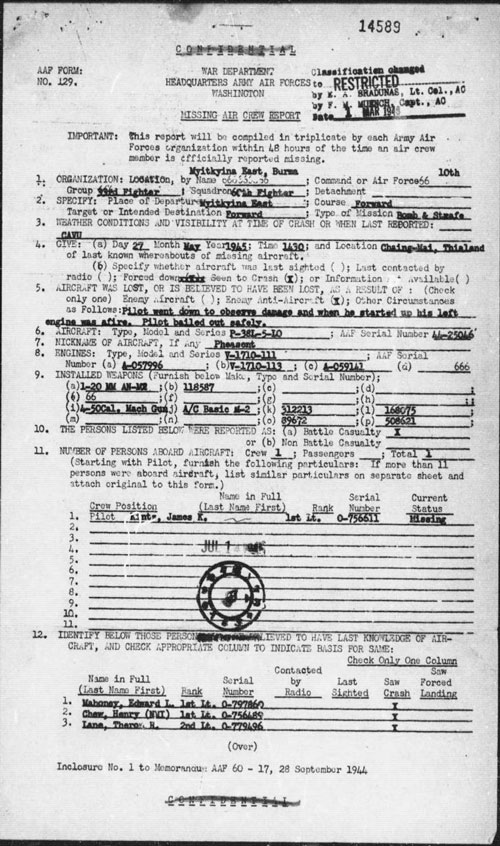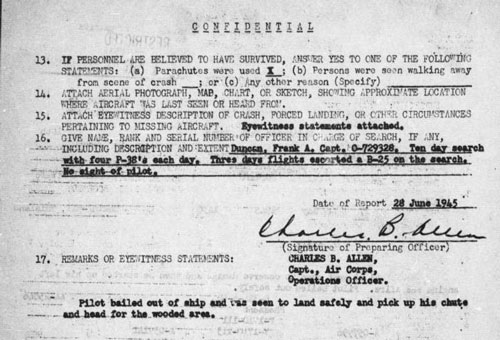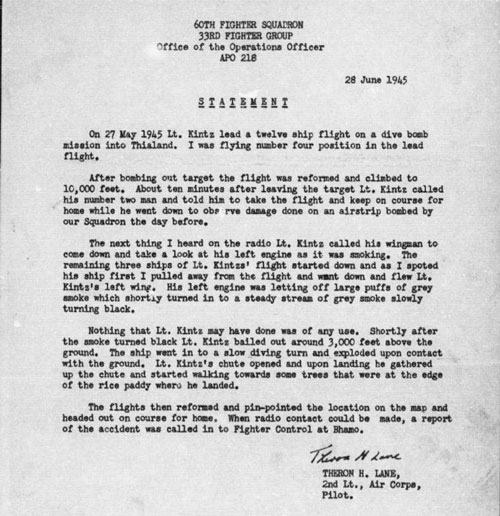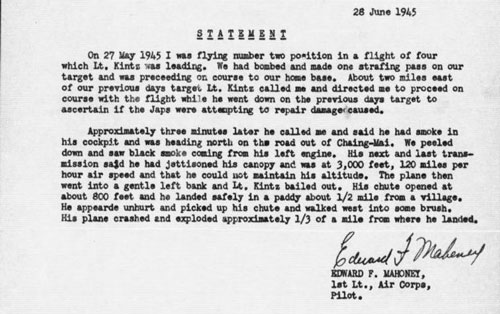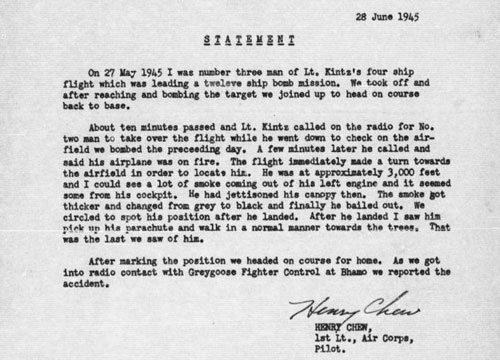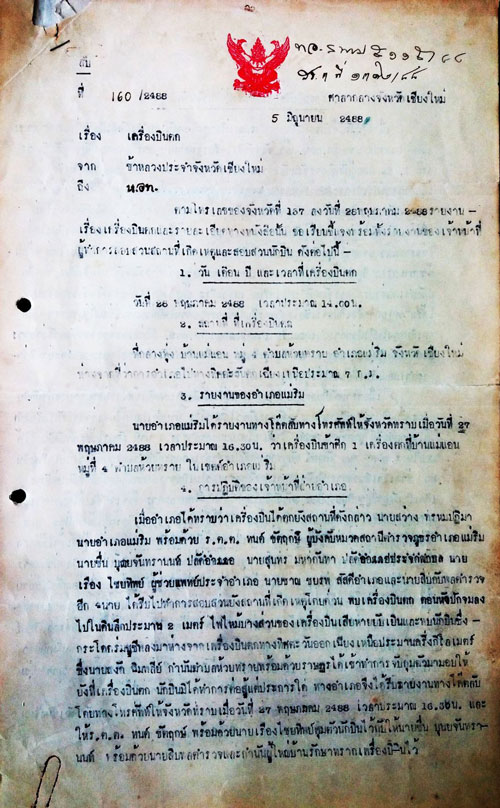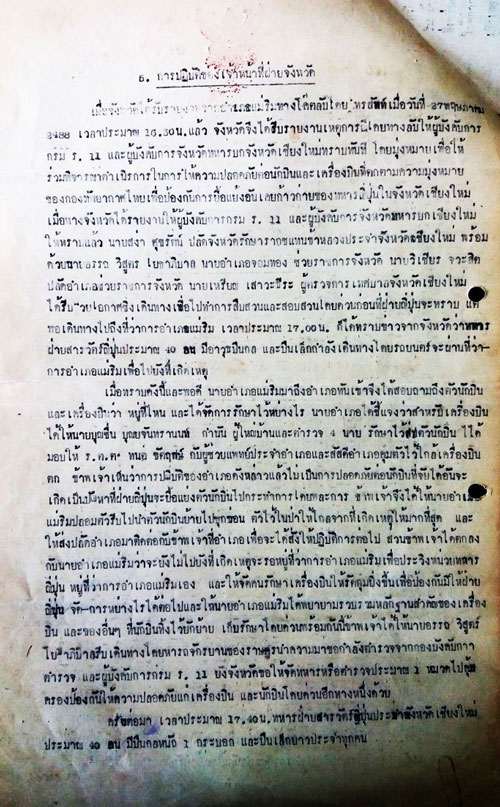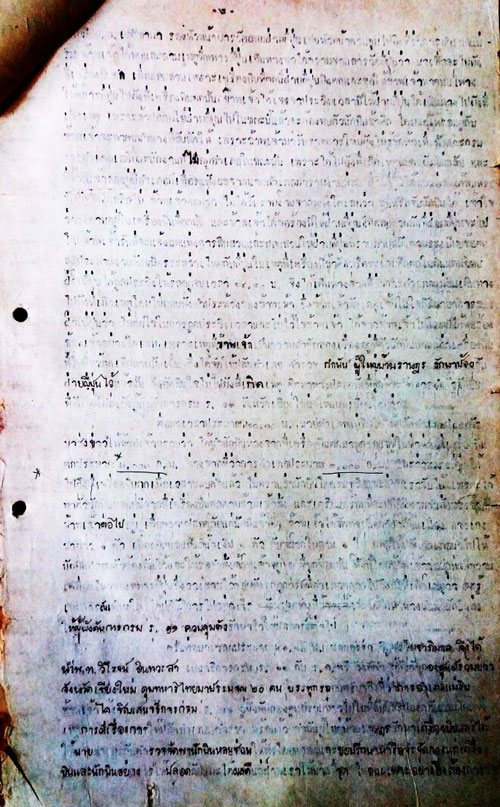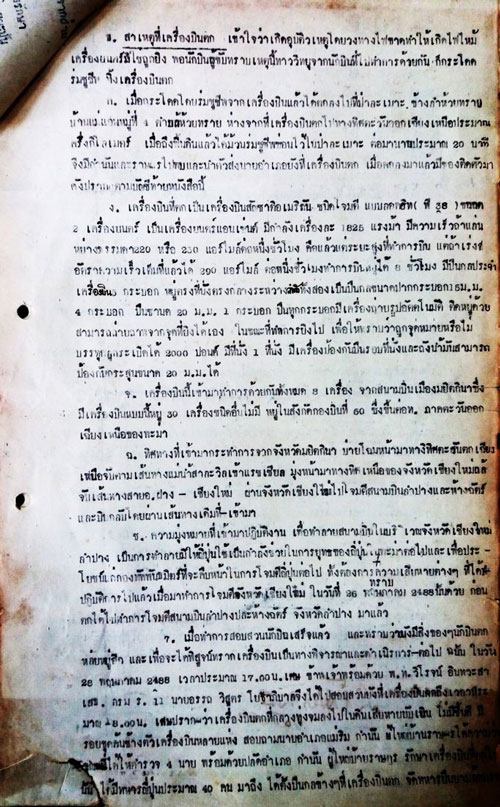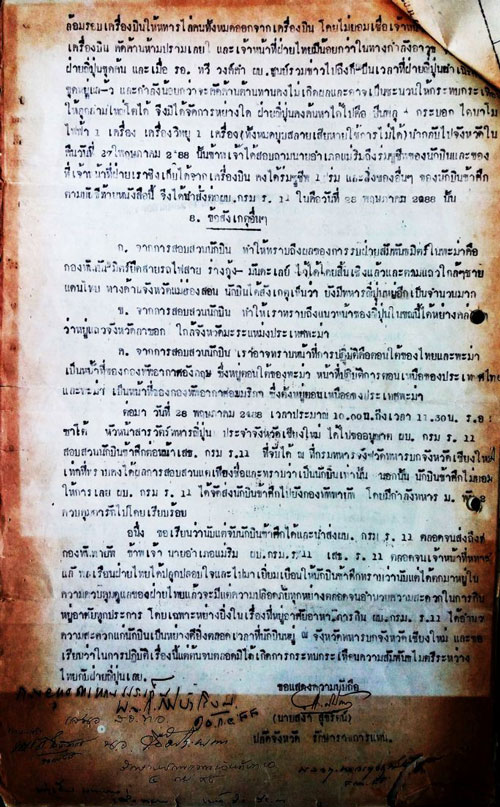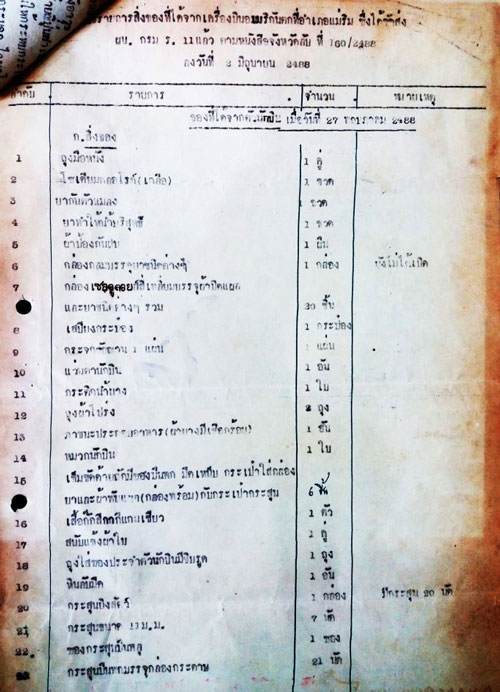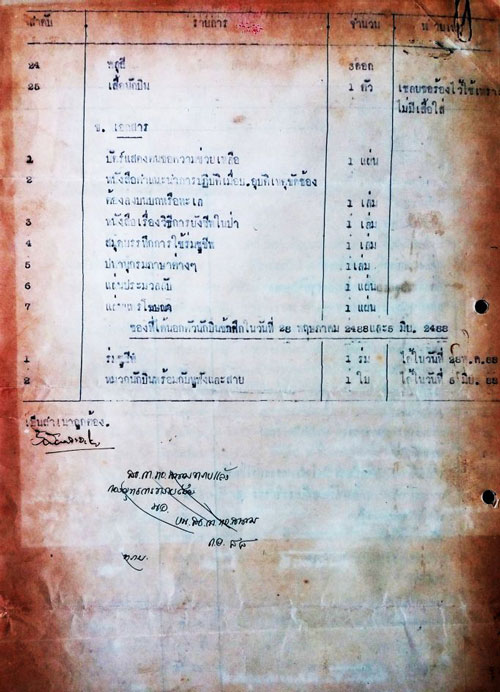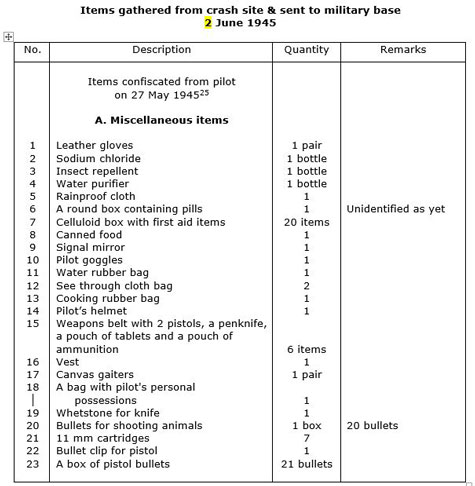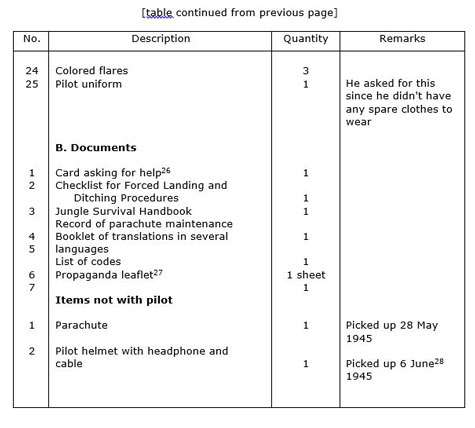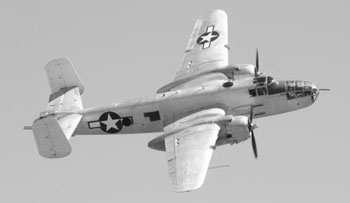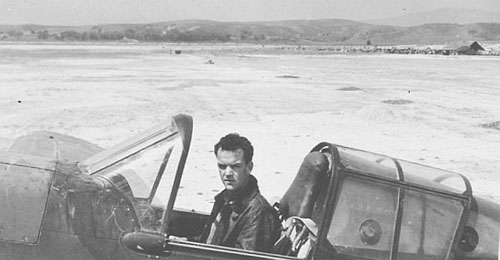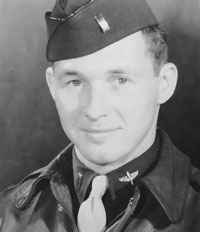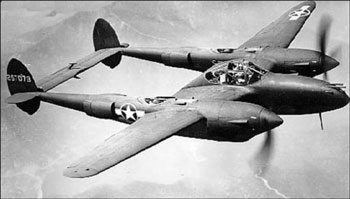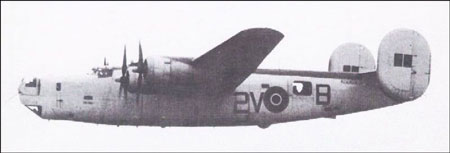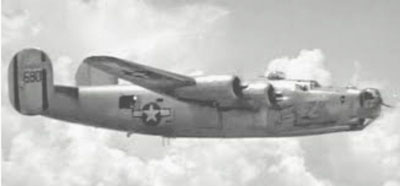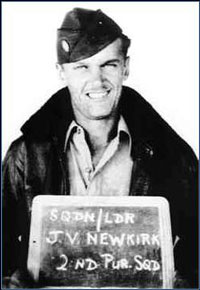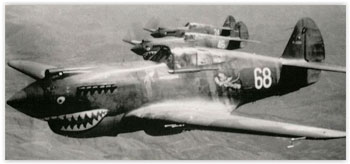27 May 1945: 1Lt James K Kintz
Supplemental pages
The five-page Missing Air Crew Report (MACR) 14589, for LT Kintz: 1
MACR Page 1:
Organization: 60th Fighter Squadron, 33rd Fighter Group, 10th Air Force, Myitkyina East, Burma
Date: 27 May 1945
Type of mission: Bomb and strafe
Circumstances: Pilot went down to observe damage and when he started up his left engine was afire. Pilot bailed out safely.
Aircraft: P-38L
Weapons: 4- .50 caliber Browning machine guns;
1-20mm AN-M2 cannon
Pilot: James L Kintz, 1Lt
MACR page 2:
Officer in charge of search: Duncan, Frank A, Capt, O-729328. Ten day search with four P-38s each day. Three days flights escorted a B-25 on the search. No sight of pilot.
Remarks of eyewitness: Pilot bailed out of ship and was seen to land safely and pick up his chute and head for the wooded area.
MACR page 3:
28 June 1945
On 27 May 1945, Lt Kintz led a twelve ship flight on a dive bomb mission into Thailand. I was flying number four position in the lead flight.
After bombing our target, the flight was reformed and climbed to 10,000 feet. About ten minutes after leaving the target, Lt Kintz called his number two man and told him to take the flight and keep on course for home while he went down to observe damage done on an airstrip bombed by our Squadron the day before.
The next thing I heard on the radio, Lt Kintz called his wingman to come down and take a look at his left engine as it was smoking. The remaining three ships of Lt Kintz’s flight started down and, as I spotted his ship first, I pulled away from the flight and went down and flew Lt Kintz’s left wing. His left engine was letting off large puffs of grey smoke which shortly turned into a steady stream of gray smoke slowly turning black.
Nothing that Lt Kintz may have done was of any use. Shortly after the smoke turned black Lt Kintz bailed out around 3,000 feet above the ground. The ship went into a slow diving turn and exploded upon contact with the ground. Lt Kintz’s chute opened and upon landing he gathered up the chute and started walking towards some trees that were at the edge of the rice paddy where he landed.
The flights then reformed and pin-pointed the location on the map and headed out on course for home. When radio contact could be made, a report of the accident was called in to Fighter Control at Bhamo.
THERON H LANE
2nd Lt, Air Corps
Pilot
MACR page 4:
28 June 1945
On 27 May 1945 I was flying number two position in a flight of four which Lt Kintz was leading. We had bombed and made one strafing pass on our target and were proceeding on course to our home base. About two miles east of our previous day’s target, Lt Kintz called me and directed me to proceed on course with the flight while he went down on the previous day’s target to ascertain if the Japs were attempting to repair damage caused.
Approximately three minutes later he called me and said he had smoke in his cockpit and was heading north on the road out of Chiang Mai. We peeled down and saw black smoke coming from his left engine. His next and last transmission said he had jettisoned his canopy and was at 3,000 feet, 120 miles per hour air speed, and that he could not maintain his altitude. The plane then went into a gentle left bank and Lt Kintz bailed out. His chute opened at about 800 feet and he landed safely in a paddy about 1/2 mile from a village. He appeared unhurt and picked up his chute and walked west into some brush. His plane crashed and exploded approximately 1/3 of a mile from where he landed.
EDWARD F MAHONEY
1st Lt, Air Corps
Pilot
MACR page 5:
28 June 1945
On 27 May 1945 I was number three man of Lt Kintz’s four ship flight which was leading a twelve ship bomb mission. We took off and after reaching and bombing the target we joined up to head on course back to base.
About ten minutes passed and Lt Kintz called on the radio for No. Two man to take over the flight while he went down to check on the airfield we bombed the preceeding day. A few minutes later he called and said his airplane was on fire. The flight immediately made a turn towards the airfield in order to locate him. He was at approximately 3,000 feet and I could see a lot of smoke coming out of his left engine and it seemed some from his cockpit. He had jettisoned his canopy then. The smoke got thicker and changed from grey to black and finally he bailed out. We circled to spot his position after he landed. After he landed I saw him pick up his parachute and walk in a normal manner towards the trees. That was the last we saw of him.
After marking the position we headed on course for home. As we got into radio contact with Greygoose Fighter Control at Bhamo we reported the accident.
HENYR CHEW
1st Lt, Air Corps
Pilot
The eight-page letter from the Acting Governor of Chiang Mai describes what happened on the ground when Lt Kintz came down in Mae Rim, Thailand.2
Complete translation of eight pages: 3
| Confidential Ref. 160/1945 Chiang Mai City Hall 5 June 1945Subject Crashed plane From Chiang Mai Governor To ห.อท.According to Provincial Telegram Ref. 137 dated 28 May 1945 which advised of an aircraft crash, officers who were in charge of the crash site investigation reported as follows:1. Date and time of accident 27 May 1945 at about 1400 hrs 2. Location of accident In a rice field in Mae Ann Village, Section 4, Huai Sai Sub-District, Mae Rim District, Chiang Mai Province; seven kilometers northwest of the district office. 3. Mae Rim District office report The Mae Rim district administrator reported to the province governor by phone using a secret code on 27 May 1945 at 1630 hrs that an enemy aircraft had crashed at Mae Ann Village in Section 4 of Huai Sai Sub-District, Mae Rim District. 4. Officer actions District Administrator Sawang Prompatima, Police Sub-lieutenant Tone Khatareug, and Bailiff Booncheun Boonyajantranone of Mae Rim District, plus Bailiff Soontaun Mahagunta of Huai Sai Subdistrict, Deputy Doctor Reung Chaitip, District Recruiter Chan Chayarobe and four police officers investigated the crash site. They found the front of the aircraft buried two meters in the ground by the force of its impact. Part of the fuselage was badly burnt. The pilot had bailed out, landing half a kilometer northeast of the crash site. Sa-ngad Chimplee, Huai Sai Sub-District Headman, accompanied by villagers, arrested the pilot: he did not try to resist. The district administrator informed Chiang Mai Province officials about the crash on 27 May 1945 about 1630 hrs and ordered Police Sub-Lt Tone and Deputy Doctor Reung to look after the pilot; and Mae Rim Bailiff Booncheun, along with the sub-district and village headmen, plus four policemen, to protect the wreckage. 5. Chiang Mai Province operation As soon as the governor was informed about the accident, he called the commander of the local army base to discuss ways to protect both the pilot and the wreckage before Japanese soldiers arrived at the crash site. Acting Governor Sa-nga Sookrad, Civil Engineer Ut Wisoot, the Chom Thong District Administrator with his Bailiff, Wichian Jawasid, who were there helping with provincial matters, plus Inspector Rean Saowateera from the Chiang Mai Municipality all rushed to the crash site to investigate before the Japanese learned of it; but, when they arrived at the Mae Rim District Office at 1700 hrs, provincial officials informed them that 40 Japanese soldiers, armed with machine guns and rifles, were on the way by vehicle to the district office. The Mae Rim administrator arrived at the office in time and told me [the acting governor, Sa-nga Sookrad] that the pilot was being held close by the plane; I thought that this was not safe for the Japanese could easily catch sight of him and take him into custody; so I had the Mae Rim district administrator don a disguise, and hide the pilot in the forest far from the wreckage. I had the bailiff come to me at the district office to help get things done. I told the district administrator that I wouldn’t go to the crash site; that instead I would stall the Japanese soldiers at the district office as long as I could. I told everyone in charge to keep a tight watch over the wreckage and to quickly gather all important items still in the plane, including documents, so that the Japanese wouldn’t find them. I had Ut Wisoot borrow a motorbike from a villager to ride as quickly as possible to the police station and to the Thai 11th Infantry Division base to ask for policemen and soldiers to protect the pilot and the wreckage. At 1740 hrs, forty Japanese soldiers led by Capt Seimada arrived at the Mae Rim District Office. I asked him why they had come and he said that they wanted to investigate the crash site of an aircraft shot down by the Japanese Army. He asked me to find someone who could guide them to the crash site. To delay them, I responded that I was newly assigned to this province and didn’t know the local people well, so it would take some time to find someone. Moreover, district officials and clerks were gone for the day and I was here alone waiting for the District Officer to return and report to me about the crash. He asked if the pilot had been found and arrested: I said that I had received no news about the pilot and assumed that he had died in the crash. I suggested that the captain not go to the crash site and that we would report the result if the pilot had survived and was interrogated, all in accordance with the Rules and Agreement for Thai-Japanese Cooperation regarding enemy aircraft or personnel found in Thailand. I was able to keep the Japanese with me until 1910 hrs; but then they set off to the crash site without asking permission. It was obvious that they were not pleased and didn’t trust me. As I thought that the pilot was more important than his plane which had crashed and burnt, I decided not to go to the crash site; but instead planned how to send the pilot quickly to the Thai 11th Infantry Division. At 2000 hrs, the Mae Rim District Officer had his deputy, who was out-of-uniform as a disguise, come to inform me that the pilot was hidden in the forest six kilometers away from the crash site, and three kilometers from the Mae Rim District Office. The Japanese soldiers arrived at the crash site after dark, not knowing that the pilot had parachuted to ground and that we Thai already had him in custody. For the pilot’s safety, I asked the Deputy District Officer to bring some local clothing, including a short sleeved blue shirt and a hat, for the pilot to wear and to tell him to standby for my orders. I kept watch for any movement by the Japanese who had been posted along the way from the district office to the crash site to find out how much they had learned and what they had done, so that I could figure out how best to send the pilot to the Thai infantry division safely. At 2130 hrs, Mr. Ut brought Lt Col Wirote Intawasa and Capt Tawee Wongkam from the Thai infantry division headquarters along with twenty soldiers to the Mae Rim District Office. I took the two of them to a secure location where I told them what I had done about the plane wreckage and the pilot; and consulted with them about what should be done next. I had the Mae Rim bailiff, along with the sub-district and village headmen, plus villagers and policemen go immediately to protect the wreckage. I had the officer in charge give the pilot local clothing to wear while he was being taken to the military base by car. I had the deputy governor and some soldiers act as guards for him on the way. The Japanese soldiers arrived at the district office at 0200 hrs on 28 May 1945. The pilot was taken to the military base at 0300 hrs with his belongings. I wanted him to have enough rest before being interrogated, so I fixed the time to question him as 0900 hrs the next day. Before I left, the Thai army officers and I agreed that I would tell the Japanese that Thai soldiers had found and arrested the pilot and had sent him to a Thai military base without informing the governor first. Japanese soldiers could contact them directly if they wanted to know more. On 28 May 1945, I, along with three other provincial officers, plus two Thai army officers, interrogated the pilot using a Thai interpreter. 6. Results of interrogation There was only one pilot: he was American, James K. Kintz, aged 24, from Wing 60 of an Allied Air Force Unit in northeast Burma. He had served there for a year and four months, during which time, he had attacked Thailand twice: the first time, Chiang Mai, on 26 May 1945; the second time, Lampang, Hang Chat, then Chiang Mai on 27 May 1945; but something had gone wrong with his plane. A short circuit caused a fire on the plane. He had informed his team by radio, and then bailed out. He landed in a wood grove near Huai Sai Creek in Mae-Ann Village, Section 1 of Huai Sai Sub-District, just half a kilometer northeast of where his plane had crashed. Twenty minutes later, the sub-district headman and villagers found him and took him to the Mae Rim administrator who waited at the crash site. The pilot brought some items with him. The plane was a Lockheed P-38, with Allison 1,825 horsepower twin engines, a top speed 290 knots, with five guns — four 15 mm machine guns and one 20 mm cannon and automatic cameras which would take pictures whenever the guns were shooting, so that the pilot could find out if he had hit targets or not. It carried 2,000 pound bombs. There was one seat with protective equipment for the pilot. The fuel tanks were armor protected, capable of withstanding 20 mm shells. There were 30 aircraft of this type in the 60th Fighter Squadron, 33rd Fighter Group located in Myitkyina in northeast Burma. Eight of them had flown this mission south out of Burma following the Salween River down to Fang, then Chiang Mai, Hang Chat, and Lampang, and returning by the same route. Their objective was to destroy air facilities at Chiang Mai and Lampang, so that the Japanese could not use them to support their fighting in Burma. Before he attacked Chiang Mai on 27 May 1945, he had already attacked Lampang and Hang Chat airfields. 7. Following completion of pilot interrogation We were told that he had left some items at the crash site. On 28 May 1945 at 1700 hrs, we went to the crash site to examine the wreckage. The district administrator, the headmen of the sub-district and the village, and villagers told us that before we arrived, 40 Japanese soldiers had searched the wreckage and dug up the ground around the fuselage. They placed a machine gun near the wreckage and all of them stood around it on guard. There were so many Japanese that Thai officers were overwhelmed, having to listen to them and let them do what they wanted. The Japanese took four flare guns, one dynamo, and one radio, none in working order. On 27 May I asked the Mae Rim administrator about the parachute and some of the items which we Thai had taken before and had him send them all to the military base the next night (28 May 1945). 8. Other observations From the pilot interrogation, we learned that the Allies had completely taken over the Rangoon-Mandalay railway. There were many Japanese soldiers near the border in Mae Hong Son. We learned that some Japanese were gathering in Rahaeng Province near Moulmein, Burma. And that the British were based in the south of Burma from where they were operating in the south of Burma and Thailand, while the US, whose bases were in the north of Burma, was operating in the north of Burma and Thailand. On 28 May, the Thai army commander permitted IJA Captain Sato to interrogate the pilot from 1000 to 1130 hrs. The Japanese got only one answer out of him — that he was a pilot; after that, the Thai army commander had his soldiers take Kintz to the Payap headquarters in Lampang. Since we had the pilot with us — and under my control as acting governor, along with the Mae Rim Administrator, the army commander, soldiers, and villagers, we were able to ensure that he was well taken care of, especially serving him the best of food while at the military base. There was no conflict between Thai and Japanese. Sincerely yours
|
| First published on Internet | ||
| Links updated | ||
